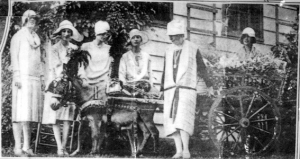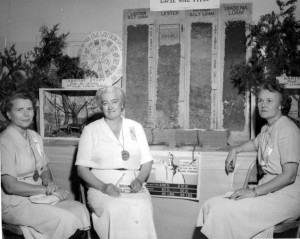History of Lake Minnetonka Garden Club – Powerful Collaborations Get Things Done

1928: Second Annual Flower Show at Woodhill, left to right: Mary Pillsbury, Olive Crosby, Helen Pillsbury, Carolyn Crosby, Mrs. George Christian, Katharine Pillsbury, and Tito, the burro pulling a Sicilian flower cart.
Since its start in 1927, the Lake Minnetonka Garden Club has become an institution—much more than its name suggests. More than a dedicated group of women exchanging gardening tips and focusing only on Lake Minnetonka’s communities along its 125-mile shoreline. As a member of the influential Garden Club of America, the LMGC’s interests are not only local, but national—even global.
The purpose of the national organization, founded in 1913, was “to stimulate knowledge and a love of gardening among amateurs; to share the advantages of association through conferences and correspondence in this country and abroad; to aid in the protection of native plants and birds, and to encourage civic plantings.” The mission remains remarkably the same. But, with increasing scientific knowledge about our planet, it may be tilted more now toward the latter part of that statement: conservation—especially related to such issues as climate change, water, and sustainable food and energy sources. A list of LMGC concerns range from billboards (1931, limiting them) to bees and pollinators (2012, keeping them busily doing their important work).
A century of cultural change has also affected LMGC’s members. More career women, along with less space, mean fewer grand-scale, high-maintenance gardens. Gardens are more manageable, often with a purpose: rain gardens (to conserve water), shoreline plantings (to prevent erosion), prairie restorations (to preserve native plants), home and urban vegetable gardens (to avoid pesticides), fairy gardens (child-pleasing fantasies adapted to tiny spaces), mazes (for contemplation)—to name a few.
LMGC has given to the community in notable ways. In 1958 LMGC donated 160 acres to establish the Minnesota Landscape Arboretum, affiliated with the University of Minnesota, and in 1959, it secured a Founders Fund grant from Garden Club of America to create the Arboretum’s master plan. In the 1980s the Club funded the Knot Garden and in 2015, with support from 100% of its membership, created an endowment for the pollinator garden at the new Tashjian Bee and Pollinator Discovery Center. The Club and its individual members have supported the Arboretum loyally and celebrate their 60th anniversary of partnership in 2018.
As for aiding “in the protection of native plants,” LMGC saved the Lake Minnetonka lotus beds (1933); donated Regal Prairie, an 80-acre home of the white lady’s slipper orchid, to the Nature Conservancy (1979); donated part of Townsend Woods in Faribault to the Nature Conservancy (1987); adopted Minnesota Trout Lily through the Center for Plant Conservation (1988). Preservation farther afield involved California redwoods (1930) and Yanachaga National Parks Peruvian Rain Forest Project (1995-97). LMGC also confronted invaders, the pretty—but greedy—purple loosestrife (attacked it with a beetle), garlic mustard (hand-pulled it from the woods), and the pesky buckthorn
Education is always high on the LMGC list, from gifts of books to schools and libraries, to conservation and horticulture scholarships and the public information that is always part of LMGC’s GCA flower shows. Flower shows also showcase specimen blooms and floral design, which has evolved from blossoms tucked tidily, but randomly, into a centerpiece to a true art form.
LMGC has hosted GCA Annual Meetings three times: in 1947 (with St. Paul and Milwaukee Green Tree Clubs), in 1976, and again in 2016 (with the St. Paul Garden Club). It was host to Zone XI meetings in 1953, 1984, and 1998.
Through the years, the LMGC has teamed up with other organizations. Besides those mentioned above, the LMGC has partnered with (and/or supported) the local Lake Minnetonka communities, the Center for Hardy Landscaping Plants, the Harriet Tubman Project, Minnesota State Horticulture Society, Minnehaha Creek Watershed District (Gray’s Bay Lakeshore Restoration Project- winner of National GCA Public Relations Award), “Partners for Plants,” Minnesota Department of Natural Resources, “Friends of the Big Woods,” Wayzata Garden Club, Wayzata Historical Society, Trust for Public Land, Hennepin County Parks, Landscape Development Center, Friends of Wolsfeld Woods, Eloise Butler Wildflower Garden, Freshwater Foundation, Lake Minnetonka Conservation District, Minnesota Waters, GCA Student Conservation Association, other GCA clubs. Powerful collaborations get things done!

Mrs. T.W. Bennett, Mrs. Cargill MacMillan and Mrs. Ruth Bovey Stevens prepared the conservation education exhibit at the 1952 Flower Show.
Other long-term commitments: 1972-95, the Camp Courage Fragrance Garden for children and adults with disabilities: 1972-92, the Freshwater Biological Center for the scientific study of lakes; the Wayzata Depot Garden, starting in 1956 and continuing to this day, Club members plant and maintain the well-visited garden at the historic depot. In 2015, using native plants, the LMGC redesigned the Depot Garden for bees, birds and other wildlife.
LMGC has hosted GCA Annual Meetings three times: in 1947 (with St. Paul and Milwaukee Green Tree Clubs), in 1976, and again in 2016 (with the St. Paul Garden Club). It was host to Zone XI meetings in 1953, 1984, and 1998.
Through the years, the LMGC has teamed up with other organizations. Besides those mentioned above, the LMGC has partnered with (and/or supported) the local Lake Minnetonka communities, the Center for Hardy Landscaping Plants, the Harriet Tubman Project, Minnesota State Horticulture Society, Minnehaha Creek Watershed District (Gray’s Bay Lakeshore Restoration Project- winner of National GCA Public Relations Award), “Partners for Plants,” Minnesota Department of Natural Resources, “Friends of the Big Woods,” Wayzata Garden Club, Wayzata Historical Society, Trust for Public Land, Hennepin County Parks, Landscape Development Center, Friends of Wolsfeld Woods, Eloise Butler Wildflower Garden, Freshwater Foundation, Lake Minnetonka Conservation District, Minnesota Waters, GCA Student Conservation Association, other GCA clubs. Powerful collaborations get things done!
